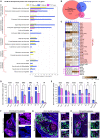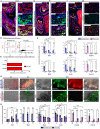Transcriptional Regulation of Jaw Osteoblasts: Development to Pathology
- PMID: 35148649
- PMCID: PMC9343864
- DOI: 10.1177/00220345221074356
Transcriptional Regulation of Jaw Osteoblasts: Development to Pathology
Abstract
Craniofacial and jaw bones have unique physiological specificities when compared to axial and appendicular bones. However, the molecular profile of the jaw osteoblast (OB) remains incomplete. The present study aimed to decipher the bone site-specific profiles of transcription factors (TFs) expressed in OBs in vivo. Using RNA sequencing analysis, we mapped the transcriptome of confirmed OBs from 2 different skeletal sites: mandible (Md) and tibia (Tb). The OB transcriptome contains 709 TF genes: 608 are similarly expressed in Md-OB and Tb-OB, referred to as "OB-core"; 54 TF genes are upregulated in Md-OB, referred to as "Md-set"; and 18 TF genes are upregulated in Tb-OB, referred to as "Tb-set." Notably, the expression of 29 additional TF genes depends on their RNA transcript variants. TF genes with no previously known role in OBs and bone were identified. Bioinformatics analysis combined with review of genetic disease databases and a comprehensive literature search showed a significant contribution of anatomical origin to the OB signatures. Md-set and Tb-set are enriched with site-specific TF genes associated with development and morphogenesis (neural crest vs. mesoderm), and this developmental imprint persists during growth and homeostasis. Jaw and tibia site-specific OB signatures are associated with craniofacial and appendicular skeletal disorders as well as neurocristopathies, dental disorders, and digit malformations. The present study demonstrates the feasibility of a new method to isolate pure OB populations and map their gene expression signature in the context of OB physiological environment, avoiding in vitro culture and its associated biases. Our results provide insights into the site-specific developmental pathways governing OBs and identify new major OB regulators of bone physiology. We also established the importance of the OB transcriptome as a prognostic tool for human rare bone diseases to explore the hidden pathophysiology of craniofacial malformations, among the most prevalent congenital defects in humans.
Keywords: RNA-seq; bone disease; jawbone; tibia; transcription factor; transcriptome.
Conflict of interest statement
Figures




References
-
- Aïoub M, Lézot F, Molla M, Castaneda B, Robert B, Goubin G, Néfussi JR, Berdal A. 2007. Msx2–/– transgenic mice develop compound amelogenesis imperfecta, dentinogenesis imperfecta and periodental osteopetrosis. Bone. 41(5):851–859. - PubMed
-
- Akintoye SO, Lam T, Shi S, Brahim J, Collins MT, Robey PG. 2006. Skeletal site-specific characterization of orofacial and iliac crest human bone marrow stromal cells in same individuals. Bone. 38(6):758–768. - PubMed
-
- Bertl K, Bertl MH, Heimel P, Burt M, Gahleitner A, Stavropoulos A, Ulm C. 2018. Alveolar bone resorption after primary tooth loss has a negative impact on straightforward implant installation in patients with agenesis of the lower second premolar. Clin Oral Implants Res. 29(2):155–163. - PubMed
-
- Beverdam A, Brouwer A, Reijnen M, Korving J, Meijlink F. 2001. Severe nasal clefting and abnormal embryonic apoptosis in Alx3/Alx4 double mutant mice. Development. 128(20):3975–3986. - PubMed
Publication types
MeSH terms
Substances
LinkOut - more resources
Full Text Sources
Molecular Biology Databases
Miscellaneous

